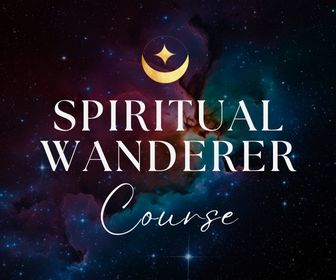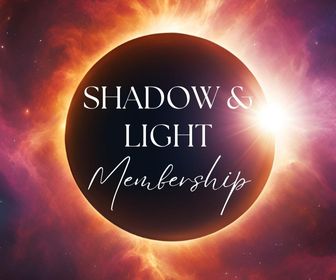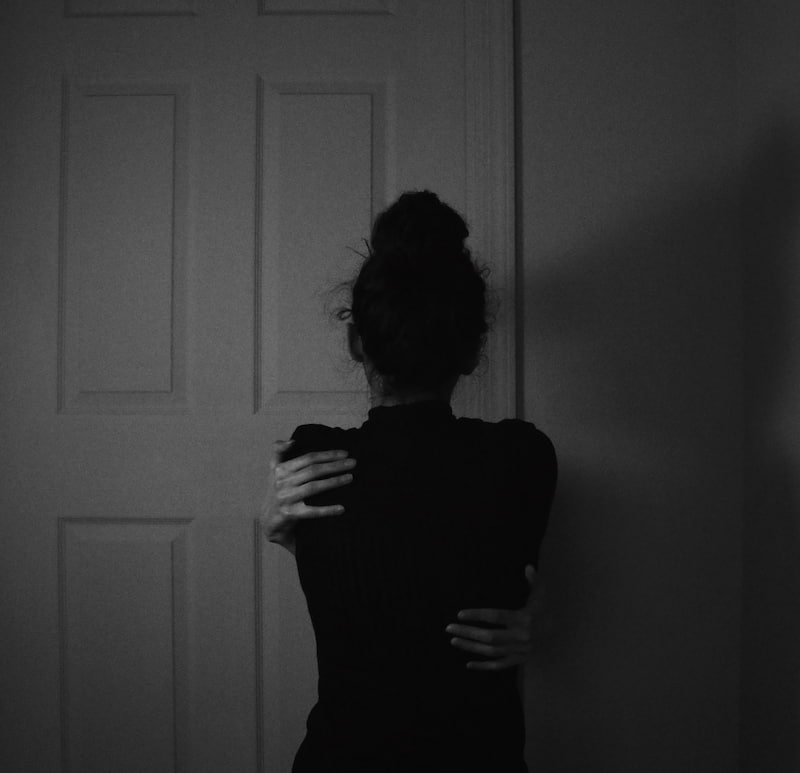Having a nervous breakdown was one of the best things that ever happened to me.
Before reaching the absolute end of my stress threshold, I never thought that finding inner peace – especially for a highly sensitive person prone to anxiety – was possible. Peace was a completely foreign concept to me.
But after undergoing multiple instances of mental breakdown, I finally learned what inner peace is (and isn’t). And it’s not what I expected.

Spiritual Wanderer Course:
Find your deepest path and purpose in life as a spiritual wanderer. In this immersive course, you get 3+ hours of content, workbooks, meditations, a premium test, and more!
As a highly sought-after state and experience on the spiritual journey, inner peace is every spiritual seeker’s secret desire.
But what actually is it? And how do we ‘find’ or ‘attain’ it?
Table of contents
What is Inner Peace?

Inner peace is what we feel when our body, mind, heart, and soul are at rest. Instead of striving to control or resist ourselves and others, we feel a sense of profound acceptance, forgiveness, love, and compassion for ourselves, others, and all of life. Inner peace is synonymous with being in touch with your True Nature: it is a state of inner rest. Perhaps most importantly, and above all, inner peace can only and ever be found in the present moment (which is all we truly have). And yet, many of us live with the assumption that inner peace can only be found “out there” in some perfect future state of being – but this very belief perpetuates our lack of inner peace.
The Key to Finding Inner Peace

Put simply, inner peace is the byproduct of letting go and surrendering to whatever this moment, this every-changing movement of life, presents to us.
Inner peace isn’t about chasing, striving, and trying to ‘earn’ tranquility. You can’t. Trying to ‘fight’ for inner peace is contradictory and pointless: it just deepens our suffering.
Instead, finding inner peace is about relinquishing our need to control and fight. Essentially, you could say it’s about giving up – but not in a disempowering way. Rather, it’s a form of resignation that is based on a deeper understanding that Life is perfectly orchestrating everything we’re experiencing based on a deep wisdom we cannot possibly fathom – typically for our growth and healing. Therefore, why the need to constantly resist everything?
“But doesn’t this mean I’ll become a pushover or doormat that people can abuse if I just ‘let go’?” you may wonder. No. Living life from a place of letting go and surrendering isn’t about allowing ourselves to be used or abused. We still need to practice self-care, self-respect, and self-love. This can mean setting boundaries, saying no, and removing ourselves from harmful situations. But letting go also means surrendering our resentment, blame, and hatred toward others. Do you see the difference? Life is about balance.

Shadow & Light Membership:
⭐️⭐️⭐️⭐️⭐ "Receiving these messages is a beacon of light and hope for me in currently very challenging times. The words of wisdom speak right to my soul, guiding and encouraging me further on my path. I highly recommend Shadow & Light to everyone who seeks to develop and cultivate a relationship with the Inner Self." – Karin
Let’s try a simple exercise that will help you to understand what inner peace feels like on a visceral and embodied level:
Sit down somewhere quiet. Then tense up your entire body. Imagine you’re being scrunched into a tight ball. Hold that for 10 or 20 seconds. Become as contracted as possible. Make yourself super stiff and uncomfortable. Then, totally release that full-body contraction. Let go. Can you feel how spacious your body is now? That’s what inner peace is like – except it radiates from the inside out.
12 Ways to Find Inner Peace

As we now know, inner peace is a movement of opening, surrendering, and letting go.
But what exactly do we let go of?
As always, let’s look within ourselves first and see all the forms of inner conflict we carry. This practice might be painful and challenging for our egos to handle, but it’s profoundly important.
Here are twelve ways to find inner peace summarized:
- Be aware of the self-improvement treadmill
- Stop expecting that life and people should be different
- Release grudges and resentments
- Sit with your emotions (and embrace them)
- Realize that you are not your thoughts or emotions
- Be aware of your obsessive need to control
- Embrace being dislikable
- Let go of playing the martyr or victim
- Forgive yourself (and therefore others)
- Understand that you don’t need to be “perfect”
- Release the need to be right
- Stop dwelling in the past (or future)
I’ll elaborate below:
1. Be aware of the self-improvement treadmill

To prevent this article from becoming another “X-Ways-to-Change-Yourself” kind of post, I want to point out that the spiritual search itself can be counterproductive. The desire to constantly improve, fix, and heal ourselves can (very quickly!) become a kind of treadmill that entraps us.
Of course, there’s nothing wrong with seeking growth and change. But please know that at a core level, you are already Whole. Your mind might be fragmented, yes, but your essence is already Whole and Complete. Place your hands gently over your heart, close your eyes, and sense into this innate wholeness and Oneness within you for a moment. Can you feel it? Can you sense that original innocence that you were born with?
Truly understanding and feeling the reality that you are already whole can save you from experiencing tremendous stress and burnout. After all, chasing an idea of perfection and running after the experience of inner peace itself paradoxically prevents you from experiencing it (because the peace you’re seeking is already right here, right now, deep within you)!
Would you like to save this?
Your information will never be shared.
So being mindful of this reality, please read the rest of this article with a light mind and heart. Everything will happen when it needs to happen. The following pieces of advice are simply pointers and places you can decide to explore and delve into at your level. No stress, no rush.
So with that caveat, let’s move on to the next mental contraction that deprives you of peace:
2. Stop expecting that life and people should be different

Here’s the reality: you can expect, and expect, and expect, and expect … but what happens at the end of the day? You feel worn out, resentful, bitter, stressed, and hopeless. What a waste of time, energy, and effort!
So much of our unhappiness stems from expectations. And usually, our expectations are totally unconscious; in other words, we aren’t aware that we’re demanding so much from other people and life itself.
Why are expectations burdensome? Expectations change nothing at all: they are like brain farts. Can you change other people? No. People only change when they decide to. And that’s just life. Understanding this is the beginning of inner peace.
Reflection:
Would you prefer to resist the truth of this present moment, or would you prefer to become an embracer of reality?
Try to pinpoint what lofty and unrealistic expectations you have for other people. Here are some examples, “My husband should be tidier,” “My boss should care more about my feelings,” “My friend should not be such a loudmouth; I wish she could be different,” “That driver should learn how to drive properly!” etc. Notice the prevalence of the word “should” here.
What to do instead? Let people be what they are. Understand that when the time is right, they’ll change (or not, but that’s their responsibility!). Ultimately, it’s not your place to force change within other people, because you can’t! (this doesn’t mean you can’t healthily communicate your needs) People only change if they want to, and that desire to change can only bubble up from deep within themselves (you can’t manufacture that for them!).
3. Release grudges and resentments

Grudges + resentments = self-righteousness … and let’s face it, feeling righteously indignant is extremely addictive in a toxic way.
When we obsessively store away past wrongdoings that others have committed, we are essentially telling ourselves, “I have the right to perpetuate my own misery.”
But here’s the thing, on your deathbed, will you really care about who is right and who is wrong?
Holding on to grudges is not only infantile, but it is also poorly spent time and energy.
Reflection:
Visualizations and rituals can help you to let go of past hurt and start a fresh chapter in life. For instance, you may like to write down what someone did to you on a piece of paper. Once you’re done, burn that piece of paper in a fireproof dish and watch as it crumbles into ash. This is a powerful ritual that can help symbolize “letting go” of a past grievance.
Alternatively, you may like to focus on cultivating forgiveness by learning how to forgive yourself first. Self-forgiveness always starts with the simply willingness to let yourself off the hook and is followed by the development of self-compassion through practices such as listening to your inner child‘s needs and affirming your worth.
4. Sit with your emotions (and embrace them)

Most people dislike sitting through uncomfortable emotions, so it’s quite a common human tendency to suppress, resist, or avoid any feeling that brings up pain.

Inner Work Journal Bundle:
⭐️⭐️⭐️⭐️⭐ "I’ve just begun, and I can tell this is an investment that will make an impression on and for the rest of my life. Utilizing these workbooks is like my best friend (ME!) right there by my side, holding my hand. Highly recommend!!!" – Monica
Unfortunately, avoidance creates emotional repression which leads to issues like anxiety, depression, psychosomatic illnesses, and other problems that make it too easy to lose touch with our inner peace.
Here’s the thing: hiding your feelings isn’t the same as dealing with them. Just because your feelings temporarily disappear doesn’t mean that they are completely gone. In fact, the longer you suppress them, the bigger they grow. And the bigger these emotions become, the more you feel an extreme lack of inner peace.
Reflection:
Find a quiet place, then choose to gently and compassionately let your emotions arise without resistance or judgment. If you struggle to allow certain big emotions arise (like rage or grief), focus on smaller uncomfortable emotions like annoyance or boredom.
Most importantly, remember that your emotions arise inside of you, but you aren’t your emotions; you’re the space experiencing them. If judgments or thoughts come about the emotions you’re experiencing, let them rise and fall away. Remember that like your emotions, your thoughts aren’t you either, you’re simply the space or consciousness experiencing them.
While it may be quite difficult at first to let yourself feel your emotions, you’ll be grateful you did so in the long run.
5. Realize that you are not your thoughts or emotions

We are the space in which thoughts appear, play, and dissolve like clouds drifting in the infinite sky.
– Mooji
As I mentioned above, you are not your thoughts or emotions: you are the space experiencing them. How can anything so changeable that is here one moment and gone the next truly define who you are or actually be you?
However, strangely enough, most of us are so identified with and attached to our thoughts and emotions that we automatically see them as inseparable from who we are. We get so swept up in the stories and beliefs that our minds generate, that we are internally tossed to and fro as though we’re in the middle of a raging storm. One moment we’re feeling happy, and the next, we’re feeling depressed and grief stricken, all because we’ve automatically believed that the thoughts in our heads are true. No wonder we suffer so much as a species!
But here’s the thing, you don’t need to believe your thoughts! You don’t need to take your emotions so seriously! After all, do you sit there and plan to think and feel everything that arises within you? Do you intricately compute and calculate the precise moment an idea, image, memory, or surge of emotion comes into your awareness and to what exact degree or intensity? No!
The reality is that you don’t choose your thoughts: they are spontaneous movements of energy that burst into your awareness one moment, and fade away the next. How can your thoughts truly define you?
In my experience, what is more liberating than believing that we can “think happy thoughts” all the time (we can’t) is to simply realize that we aren’t our thoughts, and to learn to be aware of this fact. This realization, when deeply internalized, is profoundly freeing!
Accessing inner peace becomes so much easier when we can release attachment and identification with our thoughts and emotions. We begin to realize that we aren’t the content, we are the context. We are the vast non-dual field of awareness prior to any thought or feeling, and there is great mental, emotional, and spiritual liberation in recognizing that.
Reflection:
Disidentifying from thoughts and emotions is a process that takes time, and can’t be done without some level of meditation. Spiritual teacher Jeff Foster defines authentic meditation as “Pure fascination with this moment, exactly as it is.” So learn to be curious about what is happening right here and right now. What sensations can you feel? What sounds can you hear? What emotions form a faint backdrop? What thoughts pop up? You can even note these experiences if you like (this is called the “noting technique”) to help you access more inner space and clarity.
6. Be aware of your obsessive need to control

As a former ‘control freak’ myself (okay, I still haven’t fully released this habit!), I know how much it sucks to be in a frazzled, wired state constantly. If you have the obsessive need to control everything, you’ll be a master planner who tries to predict and push every situation into what you want or feel you can handle. Of course, this equals humongous loads of stress and anxiety – the antithesis of inner peace.
Reflection:
The desire to control is a product of fear, distrust towards yourself, and your ability to handle whatever life throws at you. Once you come to believe in the innate resilience and strength of your spirit, you will start to trust yourself, and therefore you will open to life. You can read our article on finding your inner strength for more help. The obsessive need to control is also closely tied to being a perfectionist. Learning how to love yourself and healing the core wound of “being unworthy” is a powerful antidote to perfectionism.
7. Embrace being dislikable

Inner peace begins the moment you choose not to allow another person or event to control your emotions.
– Pema Chodron
Wanting to be liked by everyone is a big hangup in our society. In a world where we’re taught to gain our self-worth from external achievements and how popular we are, it’s almost inevitable that nearly all of us fall into this trap.
We let our fear of what other people think of us control our lives. Others’ perceived thoughts become our prison cells.
Due to our conditioning and societal values, many of us have such a weak foundation of inner self-worth and love that we almost always seek it from sources outside of ourselves. When we override our authentic selves to be more likable and acceptable, we give away our personal power.
Reflection:
Learn to accept being unacceptable to others. Learn to embrace the absolute worst: being disliked. This doesn’t mean being an asshole, but it does mean learning to honor your needs and wants.
Picture the very worst that could happen if someone disliked you, e.g., “My conversations with them may be awkward, they may gossip about me, they may publicly humiliate me …” etc. But can you deal with that? Could you survive it? Could you let it make you grow stronger? I’d hazard a guess to say yes, you can!
The most essential part of embracing being dislikable comes from the practice of self-compassion. When you embrace yourself, when you’re kind toward yourself, when your self-worth comes from the inside, you no longer depend on what other’s think of you so much – that becomes irrelevant. Start with the practice of self-love and compassion, and everything else will fall into place.
8. Let go of playing the martyr or victim

Adopting the role of a martyr or victim in any circumstance is an act of self-sabotage on an unconscious level.
What is a victim? A victim is someone who believes that they have no personal power and that they are a casualty of fate. They are defined by self-pity.
What is a martyr? A martyr is a person who sacrifices themselves unnecessarily for others, using this as a form of manipulation. They are defined by self-sacrifice.
Both of these roles sustain chaos and stress – the opposite of inner peace.
Reflection:
Think about the beliefs you have about yourself, others, and life. Victims and martyrs are sustained by a barrage of unrealistic, illogical, and harmful beliefs such as, “I can’t change my destiny,” “Humanity is always selfish,” “Life is against me,” “My self-worth comes from how much I give,” and so forth. Overcoming victim and martyr mentality requires a 360 degree inner shift that involves embracing personal responsibility, learning how to love yourself, doing inner child work, and working through personal shadows that keep you stuck in a small and disempowered space.
You can see our article on overcoming the victim mentality for more guidance.
9. Forgive yourself (and therefore others)

Refusing to forgive yourself for any past mistake, mess, perceived failure, flaw, or deficiency is often a product of low self-esteem. And when we go to the roots of this low self-esteem, we often find toxic core beliefs that tell us that we’re “innately bad,” “not good enough,” and so forth.
Unfortunately, a lack of self-forgiveness also means that you’re more likely to hold onto resentment and bitterness toward others. Why? When we don’t know how to forgive ourselves, we don’t know how to forgive others. How can you give to others what you yourself lack?
Reflection:
Learn to become your own best friend. Start the journey of learning to practice self-care and self-love. You’re with yourself 24/7 – so remember how important it is to treat yourself kindly. You’ll also benefit from closely examining your core beliefs if a lack of self-forgiveness is an issue for you. Beliefs such as, “I am bad,” “I deserve to be punished,” “I am unlovable,” “I’m a screw up” and so forth, are often at the core of a lack of forgiveness toward yourself and others. Learning how to work with your inner child and exploring authentic affirmations can support this healing work.
10. Understand that you don’t need to be “perfect”

Perfectionism promotes chronic stress and burnout. Personally, I’ve spent a lot of my life wanting to do everything perfectly, say everything perfectly, and essentially be the perfect person. What a waste of time!
For over a decade, we've strived to make this website a haven of free, valuable information. Imagine a world where this knowledge wasn't readily available. If this post sparked a meaningful insight or helped you in any way, please consider a donation as a heartfelt "thank you" for keeping this resource free. Every contribution, big or small, allows us to keep giving back.
We intellectually know that no one can be perfect, but yet somehow, we still hold ourselves to this unrealistic standard (usually unconsciously).
If you’re never quite happy with what you do or who you are, chances are you are a perfectionist. Remember that there really is no such thing as perfection in life, as life is about growth and change. Perfection, on the other hand, is an unchanging state, a state of death, a state that is not possible in life for us to achieve.
Reflection:
Understand that there’s no such thing as perfection – it’s totally mythological, false, and unrealistic. It’s okay to be imperfect. It’s okay to have flaws. In fact, embracing your flaws through practices such as shadow work will make you more attractive to others. People are drawn to vulnerability. Remember that. Most importantly, embracing your imperfection will help you to feel more inner peace.
11. Release the need to be right

I grew up in a religious family that always felt the need to protect their sense of being “right,” even to the point of constantly arguing and viciously debating among themselves and other people of different perspectives. It wasn’t long before I adopted the habit as well (and have since worked hard to release it).
It is absolutely exhausting trying to protect your need to feel “right” and superior to others. Embracing the possibility that you might be wrong breeds open-mindedness, empathy, humility, and inner peace. We are not always right, and that is okay.
Reflection:
Understand that you can actually learn and grow from accepting that you’re wrong. Refusing to be wrong or mistaken leads to a type of inner stagnation – a form of inner death where you are firmly and stubbornly locked in one position. That sounds kind of like being a frozen corpse to me.
The nature of life is change and transformation. Yes, being wrong is a sting to the ego, but that’s much better than staying in an egotistical, dead-ended position of rightness that steals your inner peace.
If you struggle to release the need to be right, you can always try a practice such as morning affirmations. Affirmations help to reprogram unconscious habits that keep us trapped in fear and suffering. Adopting an affirmation or mantra such as, “It’s okay to be wrong,” “I accept the pain of learning and growing,” or “I embrace the innate humility within me” will help you open to new perspectives.
12. Stop dwelling in the past (or future)

There are many reasons why we choose to live in the past or future, but all of them are pointless. Living in the past is living in death because we dwell in what was rather than what is right now.
The more we are stuck in the past, the less we can truly live our lives to the fullest in the present. The same applies to the future: it hasn’t happened yet. Stop delaying your joy and inner peace for some fantastical moment or idealistic situation in the future that will probably never happen!
The simple fact is that the past and future don’t exist in this present moment; all that exists right now is NOW. While this makes sense to most people, most of us don’t take it to heart. By getting lost in past regrets or future fears, we completely lose touch with the grounded present moment. Inevitably this disconnection from the here-and-now results in heartache, tension, and overwhelm … the stuff nervous breakdowns are made of!
Perhaps the biggest danger of dwelling in the past or future is that you never truly feel alive in the present moment (which is the only moment). Not only can’t you feel grateful for what you already have, but you also can’t absorb the innate magic and beauty of life around you. Dwelling in the past or future is a huge reason why so many of us lack inner peace.
Reflection:
Practice gratitude, which means finding joy in what you already have right now. One way I incorporate gratitude into my daily life is by keeping a “gratitude stone” near my bed. Right before I go to sleep every night, I think of at least five things I was grateful to have experienced during the day, and I let the feelings of joy and satisfaction wash over me. (See our article on being grateful for more guidance.)
Learning mindfulness exercises which can help you stay connected to this present movement of life will also be extremely valuable. While focusing on your breath is a popular way to stay grounded, I personally prefer to feel the ground beneath me or listen to sounds – so feel free to try this out if mindful breathing has never resonated with you!
Other Ways of Experiencing Inner Peace

Now that we’ve explored the main inner mindsets and habits that create suffering, and some healing reflections and practices, here are some other simple and supportive inner peace practices you can explore:
- Spend time often in nature – this is a powerful way of connecting with your inner wellspring of peace and tranquility. If you don’t have access to a park, woodland, or other natural space, spend some time gazing into the sky. Watch the clouds come and go or any birds that fly by. You can even listen to a sounds of nature recording to remind you of the deep and innate peace found in nature, and also found within yourself (because you are nature!).
- Make space for solitude – spending time alone helps you to re-orient to your heart and soul’s innate serenity. When we’re in loud and busy places, it can be hard to tune into the still and soft voice within. Solitude helps you to come back home to your Self again. If external solitude isn’t possible for you right now in life, invite the possibility of inner solitude. Perhaps you can walk around with noise cancelling headphones, move throughout your day more slowly and mindfully, or use a mantra to disengage from your thoughts and return to stillness again.
- Embrace essentialism and minimalism – in other words, simplify your life and commitments and prioritize your inner peace. Your external world influences your internal world, and vice versa. Clutter within your personal space often symbolizes clutter within the mind. You’d be surprised how internally spacious you can feel after clearing out, recycling, and donating items that no longer bring you joy.
- Meditate each day – even if you’re not “a good meditator,” realize that there are so many forms of meditation out there to try, from mantras and visualization to dancing and vipassana. Meditation doesn’t have to involve sitting quietly for a set amount of time each day, unless that calls to you. Explore what approach to meditation (which means being present to whatever is happening) appeals to you the most. Is knitting a form of meditation for you? Do you prefer tea drinking meditation, dog walking meditation, singing meditation? Meditation can be incorporated into any facet of life! It doesn’t have to be about sitting on a pillow in an uncomfortable position if that is inaccessible to you. My favorite form of meditation, for example, is nature-watching meditation. Just sitting and observing nature and how it moves (the trees, clouds, grass) brings me indescribably peace and tranquility.
There are many paths to inviting more inner peace into your life, but these are the essentials. I hope they can be of service to you. Feel free to share what has worked for you in the comments!
Inner Peace is About Letting Go

Remember that, at your core, you are the stillness and inner peace that you seek.
Liberation isn’t about searching and seeking: it’s about letting go. It’s about connecting with what’s already and always here beneath the turbulence of the mind.
The more aware you can become of your mind’s contractions and conditioned patterns, the more liberated you will be to dwell in the Ocean of your being rather than just getting caught up in the waves.
Inner peace is not something we chase or achieve “out there in the future”: it’s something we rediscover, right here, right now. That realization itself is a doorway to inner peace.
Has this article helped or inspired you? You’re welcome to share it with a loved one! What is your biggest block to inner peace?
If you need more help, we offer 3 powerful ways to guide you on your inner journey:
1. The Spiritual Wanderer Course: Feeling lost or uncertain about your path and purpose in life? Gain clarity and focus by learning about the five archetypes of awakening within you. Discover your deeper path and purpose using our in-depth psychospiritual map. Includes 3+ hours of audio-visual content, workbooks, meditations, and a premium test.
2. Shadow & Light Membership: Seeking ongoing support for your spiritual journey? Receive weekly intuitive guidance and learn to embrace your whole self, including your shadow side. Deepen your self-love and receive personal support from us.
3. Spiritual Awakening Bundle: Ready to soul search and dive deep? Access our complete "essentials" collection of beloved journals and eBooks. Includes five enlightening eBooks and seven guided journals, plus two special bonuses to further illuminate your path.



 $3
$3



A lot of people just focus on right and wrong when it comes to religious doctrine, or even societal norms. Some people differentiate things, and say it’s a logical thing or an emotional thing, but blind obedience to such ideas are not even something that makes sense by the standards of mature logic or mature emotion. With mature logic, you can come up with many arguments against whether something makes sense or not, to see if something really creates the effect you desire or want to avoid. With mature emotion, you can find it within you that empathizing with others’ emotions and your own heart’s drive is where the answer of what is right and wrong is. Rules in of themselves are not very logical. It is a bit like Euclid’s geometry. Propositions in math have to start with underlying surface assumptions, and in math, we have to assume as a rule that 1 + 1 = 2. If you start with a faulty surface rule, like 1 + 1 = 3, then that’s not logical just because you make it a rule. Also, even when you have emotional sentiments about certain rules in society, and you feel it is something your heart desires, it’s not really from a mature emotional place, because it’s out of a fear of punishment that you avoid something, not because you really love it or enjoy it. So with this, you can conclude that the standards of society, religious, political, cultural, or other, are neither true by the standards of logic and emotion, but mostly because “Someone said so,” and it’s true “Just because they say so.” And if enough people say “it’s because we say so,” that’s enough to convince most people.
Just going to read this every day until it becomes a habit. In 37 years or so, I might have more of this peace in my life. ❤️
Beautiful 💗
Great, thanks! Brought me at least a bit back to where I feel I belong and what’s good for me. I’m having a really demanding and stressing job, and after work I tend my garden (more work), and though I like the work – both my bread job and my garden – I take little to no time for my own wellbeing (except for reading your weekly articles). So I get lost on my way again and again. Although I feel I really need to meditate or do journalling, I seldom do so because I’m too exhausted. Good excuse, I know. I really work from 6.30 till dusk. Should set me thinking…
I really need your articles to remind me that work isn’t all there is in life, there’s more to life and I need to get my ass moved, take my notebook and just write, no matter how much time is ‘wasted’ in which I could do ‘someting useful’.
Btw, if I may say one thing about your articles, it’s that you mostly use pictures of women. There are only few pictures on men, which implicitly says, all this talk about soul searching is ‘a girl’s thing’. Is it?
I’m honored that these articles and guides are a way that you practice self-care, Sabine, that is just beautiful 💗
As for the images of women, I’m not sure if I have a bias because I’m a woman and I write and edit a lot of these articles – or maybe there’s also a bias ingrained in the more “soft” or “spiritual” looking pictures available out there to choose from being primarily female-based – but I hear you. I’ve been trying for a few years now to include more gender inclusive/neutral pictures, such as including a lot of nature imagery or images of hands or silhouettes that you can’t tell are male/female or non-binary. As always, whatever I create and share is a work in progress and always imperfect in some way.
So I hope all the guys out there (or nonbinarys) reading this article know that it’s just as much for them as it is for women.
WOW. Thank you Aletheia. This would have to be the best article I’ve read. Absolutely amazing.
That means a lot to me to hear, Chris, thank you! 💗
This is an EXCELLENT article! Thank you :)
Thank you Mahina! :)
Lovely, informative article, thank you.
I can’t even begin to tell you how much you guys have helped me. I have had the most turmoil in my life this last year, you wouldn’t even believe. It seems like it just keeps on getting worse, however I had a complete breakdown this week and I am slowly trying to ground myself and come back, but it’s hard and it would be even harder had I not had your help. Granted I have a lot of work ahead of me, but as I read your articles and messages, it hits me in my soul and then I know that I am going to be ok if I just keep going one step at a time. Thank you for the work you have put into these messages for people like us. Without happening upon Lonerwolf, I don’t know what shape I would be in right now.
Thank you for half of the story; the spiritual half. Thank you for highlighting those areas where we stop ourselves from letting go and embracing our true nature. What your representation misses is the other half where we have to consciously ‘build ourselves up’ to maximise our presence in the world, realise our potential to ‘make our mark’ in whatever way is appropriate for us: business, family, the arts etc. Or, when challenged, to hold it together. We are, after all, suspended between the two poles of existence – spirituality and fate – and both must be embraced. Not for nothing have rituals and sacrifice established themselves in all the world’s religions. But, as with our spirituality, it isn’t the actual process of what we do – meditation, yoga, tai chi for example for spirituality – but what the process inspires and which we have to trust will benefit us. And for our fate it starts with prayer and the faith that needs to underpin it. And from my own challenging life-experience – especially in the middle of the night when the challenge is at its greatest and determines how I shall be the following day – I can vouch for the ‘power of prayer’. Whilst we work to ‘lose ourselves’ in our spiritual practices we must work consciously to ‘find ourselves’ with the higher powers that rule our fate. We must defer to them, acknowledge their power and deliberately ask for their help. It’s as simple – and as difficult – as that. I say ‘difficult’ because as it’s often difficult ‘letting go’ it can be difficult ‘reaching out’ for the same reasons. And it needs faith. I didn’t have faith before but since I ‘faked it to make it’ I have found some faith and it really makes a difference. As a (lapsed) Anglican this particular Son of God needs to seek not just the Holy Ghost but God the Father. Only in this way does this image and Christ’s ministry make any sense for me.
Not everyone wants to follow an organised religion.
I found the article excellent and complete.
When I read this, it took me a few days to read and digest. I got a lot out of this as it truly relates to me all the way.
I am working on my insecurities and these points that you have outlined here really helps.
It’s a pleasure to help ♡
I am sitting in morning